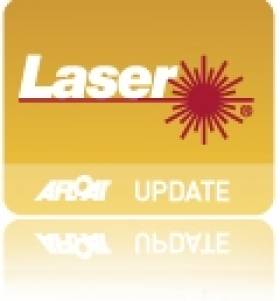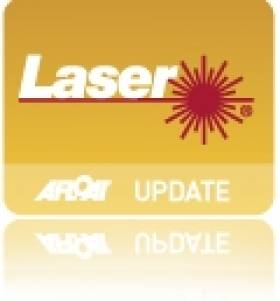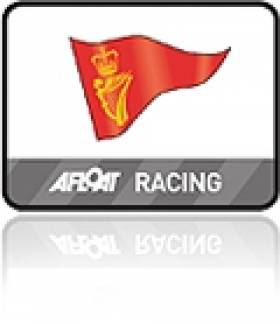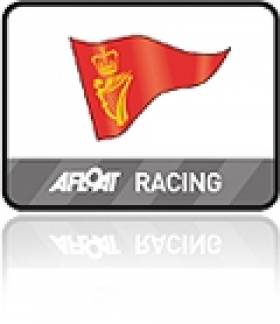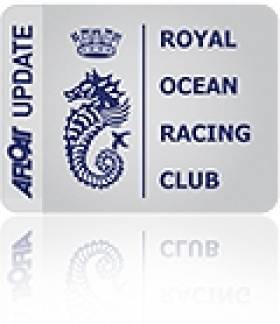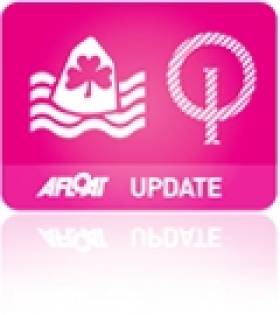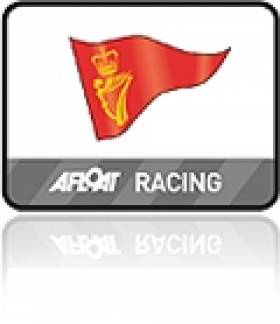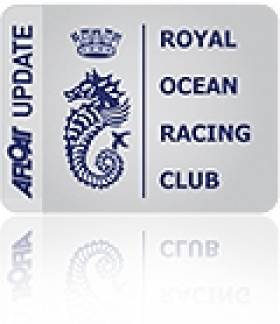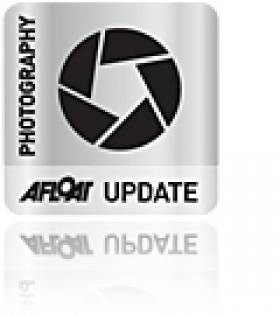Displaying items by tag: Royal Cork YC
Irish Youth Sailors Lead at Royal Cork Laser Nationals
#laser – Irish Youth Sailors from the National Yacht Club in Dun Laoghaire are making their mark at the Laser Nationals at Royal Cork Yacht Club in Cork Harbour this weekend. After Two races race sailed, Philip Doran has a single point lead from Russian visitor Maxim Nikolaev of Y CDP Khlebnikovo. East Antrim's Chris Penney is third in the 34–boat standard rig division.
After some hours waiting for a start yesterday with the wind about 5 miles an hour from the North/NW they eventually got a course set up and went into a start sequence.
In the 79-boat radial division, Doran's club mate Finn Lynch, the 2012 ISAF Youth Silver Medallist, counts a 2,6 and 4 to lead from Baltimore's Fionn Lyden with a three point margin after three races. Lyden, significantly though, won yesterday's second and third races. Australian visitor Tristan Brown of RFBYC is third.
In the Irish Laser 4.7 National Championships, with 38 entries and three races sailed, Royal Cork's own Billy Duane leads.
Laser National Championship Day One Scrubbed Due to Lack of Wind
#laser – In spite of every effort being made for the first day of racing at the Irish Laser National Championships at Royal Cork Yacht Club, the scheduled racing has been scrubbed this afternoon due to lack of wind.
A fleet of 150 boats launched in three divisions including 79 radials.
It was hoped the prevailing easterly five knots off Roches Point in Cork Harbour would be sufficient to get the Olympic dinghy fleet round a modest course but even this light wind proved too fickle to allow a fair race. The three fleets got started but a dying breeze led Race Officer Dave O'Brien calling it a day before the race finished.
O'Leary to Lead Royal Cork Again at New York Cup
#rcyc – The Royal Cork Yacht Club will be led once again by Anthony O’Leary when they compete in 2013 at the 2013 New York Yacht Club Invitational regatta. Having finished fifth and eighth in the first two editions of this Corinthian event, O’Leary is looking forward to “third time lucky” in Newport as a majority of the RCYC team has competed in one of the previous events.
Many of the world’s best known yacht clubs were established under royal patronage or granted the privileged title at some point in their history. Eleven that fall into that category are among the 20 yacht club teams that will compete from September 7-14, 2013, on Swan 42s in the 2013 New York Yacht Club Invitational Cup including Real Club Náutico de Barcelona (Barcelona, ESP), Royal Belgian Sailing Club (Zeebrugge, BEL), Royal Cork Yacht Club (Crosshaven, IRL) and the Royal Swedish Yacht Club (Stockholm, SWE).
The 9th Lord Inchiquin not only established Royal Cork Yacht Club in 1720, he lent his castle on Hawlbowline Island for its activities and in doing so founded what is generally considered to be the world’s oldest yacht club. Since 1831, by grant of King William IV, the club has carried the Royal prefix. In more recent history RCYC has demonstrated their competitiveness in events ranging from the Admiral’s Cup to the Olympics. Their participation in the 2013 Invitational Cup will once again see Anthony O’Leary leading the Irish team. “Good old-fashioned one-design skill and teamwork is of paramount importance at this event, and we rely on the Technical Committee to equalize the boats – leaving us sailors without excuses if we don’t perform,” said O’Leary. “We only get the chance to sail in one-design boats of this size at Newport, and the international dimension elevates this event to its being our number one priority for 2013.”
Established in 1876, the Real Club Náutico de Barcelona, which was granted the Royal distinction by Alfonso XIII in 1888, is one of the oldest yacht clubs in Spain. Located in the modern yacht harbor of Port Vell, RCNB is surrounded with evidence of Barcelona’s position in history as the greatest maritime power in the Mediterranean by virtue of its strategic location on the Balearic Sea. The Old Port Authority, an ornate structure built in 1907 as a maritime station, is nearby, as is the Museu Marítim which is housed in a landmark building on the site of the medieval shipyards. A focal point of this historic area on Barcelona’s bustling waterfront is the 197-foot-tall Columbus Monument that was constructed in 1888 to honor the explorer’s first voyage to the Americas.
The RCNB team will make its third attempt to win the Invitational Cup, and this edition will see Javier Scherk at the helm for the second consecutive time. “This is the best regatta by far I have ever done,” said Scherk who is assembling a team that has sailed together for 40 years on a variety of boats – starting with a Ron Holland half-tonner and now a J/80 – named Gunter.
“My father built up a crew of very young people and we are still sailing together,” said Scherk, who explained that his teammates have all been 470, Finn or Laser sailors, and together were second in class in the Round the Island Race (Isle of Wight), while also competing in IMS and ORC races, as well as in the Melges 32 class. Scherk noted that better understanding of the Swan 42, and being together more as a team, form the basis of the team’s preparations for the upcoming regatta.
The Royal Belgian Sailing Club, founded in 1863 on the Leie River in Ghent, and receiving its royal designation in 1873, is the largest sailing club in Belgium with over 2,500 active members. Initial competitions were held on the canal linking Ghent to Terneuzen. Today, however, after relocations necessitated by the first and second World Wars, the club has operations in Zeebrugge, Heusden, Duinbergen and Het Zoute.
“Our club is celebrating its 150th anniversary this year,” said Commodore André Annicq who noted that the anniversary festivities would include a royal visit from Prince Philippe and Princess Mathilde later this month. “The Invitational Cup is presented as one of the lead events during this celebration year,” he added.Regular practice for RBSC’s first entry in the Invitational Cup is taking place on a Swan 45 owned by Patrick Van Heurck who will lead the Invitational Cup team. In the coming months, while negotiating logistical challenges posed by team members residing across the globe, the “tenacious” Belgian team will charter a Swan 42.
Formed in 1830, the Royal Swedish Yacht Club (KSSS) was given royal status in 1878 and is the oldest yacht club in Sweden as well as in Europe outside the British Isles. International recognition accompanied the success of several club members: Eric Lundberg, who in 1929 won all 11 races in the Swedish-German-American Square Metre event off the coast of Marblehead (USA) and was deemed an important ambassador of the class by noted yacht designer L. Francis Herreshoff; Erik Åkerlund, won the gold at the 1932 Olympics, and Sven Salén, who won bronze at the 1936 Games, both in the 6 Metre class. Since the 1920s KSSS has organized the most prestigious race on the Baltic Sea, the Round Gotland Race. The club is also the Challenger of Record for the 2013 Americas Cup.
“We know it’s highly competent teams, who have sailed Swan 42s for a long time, that participate,” said Team Captain Douglas Eklund on the club’s first entry in the Invitational Cup. “We know that the races are tight and we have made great connections with local Swedish sailors living in Newport to learn more about the sailing waters. Some of us have sailed Swan 42s before and we know how important the team work onboard this boat is.”
“Most of us in the team are sailing addicts for life, and Newport is historical grounds for us. This is a unique opportunity for us to be a part of the real sailing in Newport.”
#rcyc – It was as a Thursday night should be! This is a quote from former RCYC Admiral Conor O'Donovan as he returned to the club after racing on a glorious summer evening writes Claire Bateman. It was the first evening of the Union Chandlery league and the Royal Cork clubhouse looked resplendent with the new mosaic compass at the base of the flagstaff and the newly awarded Eco blue flag for the Royal Cork marina flying proudly in the warm evening breeze.
The twenty six strong fleet sailed in a 10knot E/SE breeze. Adrielle was the committee boat with Paul O'Shea as principal race officer and he sent the fleet on a course first to Corkbeg and then to Cuskinny before a beat to East Ferry 2. They then had a run against the blinding wonderful sunset to No. 12 and had some loops between Corkbeg and Grassy. The whitesail fleet only had one loop before finishing the race.
The evening ended with a BBQ for competitors.
Royal Cork's Anthony O'Leary's Antix, will have his son Olympic helmsman Peter on board the Ker 39 for RORC's weekend Myth of Malham race.
The offshore race starts this Saturday from the Royal Yacht Squadron Line. It is a 230–mile race from Cowes, round the Eddystone lighthouse and back to the Solent and marks the Irish Commodore's Cupper's offshore debut.
"Antix is entered for the Fastnet this year. We will have a good test in Ireland with the Dún Laoghaire to Dingle Race but the quality of the opposition and the route for the Myth of Malham is ideal for our preparations. O'Leary said. 'Looking at the long-term weather forecast, it looks like a northeast wind, which will suit the reaching machines more than us but forecasts can change ' he said.
'We are very happy with the changes we made to the boat last year but the best way to truly find out if you are fast is to race against the best' he added.
The RORC Season's Points Championship continues over the May Bank Holiday weekend with one of the longest races of the season. Fresh from victory in the North Sea Race, Piet Vroon's Dutch Ker 46, Tonnerre de Breskens 3, is the scratch boat in IRC One but will surely be under tremendous pressure from three Ker 40s: Harmen de Graaf's Baraka GP, Edward Broadway's Hooligan VII and Andrew Pearce's Magnum III. Mike Greville's Ker 39, Erivale III, is a former winner of the race.
120 yachts have entered the Myth of Malham Race and no doubt many teams see the race as a dress rehearsal for the first part of the Rolex Fastnet Race. However, the race from Cowes, around The Eddystone Lighthouse and back to the Solent, can be extremely tough, as the competitors in last year's race can testify.
In IRC Four Harry Heijst's Dutch S&S 41, Winsome, was one of only three yachts to complete last year's race, coming second overall and winning class. The veteran Dutch skipper will be racing agin this year and commented: "I am 67 years of age and I have done a lot of racing; round Britain and Ireland, the Fastnet, the Sydney Hobart and I remember a very tough St. Malo Race but I have to say that the 2012 Myth of Malham Race was one of the hardest races Winsome has ever done. The waves were five metres high going past The Needles and the cockpit filled up with water on several occasions. This year looks like it will be a colder race but hopefully in 20 knots less wind." For this year's Myth of Malham Race, Winsome will be defending their class title against 35 other yachts, including a gaggle of seven Sigma 38s and proven race winners, such as Jean Yves Chateau's Iromiguy and Noel Racine's Foggy Dew.
Two-Handed racing with the Royal Ocean Racing Club has been going from strength to strength and 17 teams will take part in the Myth of Malham with just two crew on board. Robin Elsey is just 20 years of age and won his first ever RORC Two-Handed race last month, racing Figaro II Artemis 21 in the Cervantes Trophy Race with Sam Matson.
"Winning class in the Cervantes Trophy Race was just brilliant," commented Robin, " but the Myth of Malham is a very different race, it is very tactical with all of the different tidal issues along the headlands and it is a much longer race but it is so long that you can really get into a rhythm. It will be important for us to get the balance between going flat out and backing off just right but personally I am also looking forward to the race because I come from Cornwall so I will be racing in my own home waters."
Todd Wells' Je Vante is one of ten J/109s entered for the Myth of Malham. "The big entry shows that a lot of yachts are using the race as a significant part of training for the Fastnet. Depending on the weather, this will be a particularly sanitizing event for crews at all levels. Last year was incredibly tough but that is part of the attraction of offshore racing, you either talk about it in the bar or get on with it."
John Allison will be racing J/109, Jumbuck, for the first time but John and the vast majority of his crew are experienced offshore sailors. "In my honest opinion, the first 24 hours of any ocean race are easy, the next 24 the hardest, and then one normally settles into a pattern that gets progressively easier as each day passes. So maybe there is a case for saying overall, the Fastnet is not as hard as the Myth of Malham," commented John. " Having said that the race will be a good training exercise for the Fastnet, as it allows one to get familiar with that coastline in race conditions. As Jumbuck is a new boat for us for the race, it will bring the pleasure of bringing a crew and new boat up to speed, not just against other yachts, but also against weather and routing conditions."
Capstan Sailing's Yuri Fadeev is the skipper of Reflex 38, Intuition. "It's the first Fastnet for most of the crew, so we are taking qualifying races very seriously to get into shape. The crew is from UK, Russia, Latvia, Lithuania and Ukraine with a great mix of abilities but some of the guys have sailed with us for a few seasons now. As most of the races we do are on a commercial basis, safety is paramount, and most of the preparation effort goes into that, although we do like to give the competition a bit of a challenge, so making sure the boat is fast is always a good thing. I am sure the guys will know all about beating by the time we round Eddystone!"
Line Honours favourite for the race will be Andrew Budgen's Volvo 70, Monster Project. "This is the first time we have entered this race and dependent on the weather it could be quite hard but it is much shorter than the Fastnet Race and there is no Celtic Sea to worry about. The start mirrors the Fastnet but the weather at this time of year will be very different but saying that, the tide areas will be very similar. The crew is mostly friends that have previously sailed on our Volvo 60, all good amateur sailors. As always, the race will be a test of mental as well as physical strength."
Huge excitement this morning as the top 56 Optimist youth sailors in Ireland congregate in Royal Cork Yacht Club for the second leg of the 2013 Trials series in Cork Harbour.
The Trials series takes place over two long weekends. Comprising 16 races it is the selection process for the 2013 Optimist teams. 19 sailors will compete in the Optimist World Championships (Lake Garda), European Championships(Lake Balaton, Hungary) and the French Nationals (Crozon, Brittany).
In addition, all sailors in their 12th year or younger will be selected for the Under 12 squad which will compete in the UK Optimist Nationals in Largs, Scotland.
The first leg of Trials traditionally coincides with the Youth Nationals event, so 8 races have already been completed in Lough Derg Yacht Club over the Easter holiday. The host club for the second leg (RYC) is watching its own sailors anxiously as four of them are currently placed in the top 5 positions, which will make the Worlds team - Harry and Johnny Durcan, Richard McGinley and James McCann, with Alix Buckley (SSC) the only girl in the top 5.
On the water, the Race Officer on Irish Mist was able to set up his mark close to the no. 10 buoy thus giving a long beat in to Luck beach and the fleet got in three races today and the trials continue tomorrow and Monday.
The first race of the two Royal Cork Yacht Club May leagues took place last night, Friday May 3rd and over twenty boats came to the Cork Harbour starting line on what was a grey misty evening in a brisk W/SW breeze writes Claire Bateman.
What the weather lacked was more than made up for by the excitement on the racecourse with many of the yachts on their first outing of the season and it was certainly enough to wipe away the cobwebs.
After a beat to Cage it was time to hoist spinnakers for all except of course the whitesail fleet and this is where it started to get interesting. Only the five 1720s and Leonard Donnery's 'No Gnomes' were holding them until they got to the turning mark off Cuskinny. Having a first outing in the latest 'Alpaca' was Paul Tingle in the former 'Allure".
After racing everybody returned to Royal Cork Yacht Club to the warmth and welcome and enjoyed musical entertainment.
Perfect sailing conditions on the south coast marked the finale of the Marshall Marine Textiles April sailing League at Royal Cork Yacht Club on Saturday writes Claire Bateman.
There was a northerly breeze tempered by the bright sunshine and the cruisers were sent to No. 5 before beating in the harbour to No. 10 and then on to a course that gave them plenty of running, reaching and beating before returning to finish at Grassy. The day was described by Batt O'Leary, winner of IHS, as a wonderful and most enjoyable day of sailing of which there have not been too many so far this season.
Also sailing in the harbour were Fevas and some Laser Radials out for practice. However, the biggest gathering of boats was reserved for the Optimists, with the beginners group having a ball with their Instructors and other more senior Optimist sailors giving a helping hand.
Also in view of the forthcoming Optimist trials next weekend for the International Team, a group of Optimist Sailors from Kinsale Yacht Club were working up and joined with a group from TeamX Training from Dublin who were accompanied by their Coach Denis Passke assisted by Séafra Guilfoyle and they later joined in with the regular Royal Cork Optimist sailors racing under Race Officer Michael McCann.
Hopefully today saw the start of the fine weather for the coming sailing season and the new Optimist Class Captain, Frank Thompson, should be very pleased with the success of the day and the previous weekend highly successful novice intruductory session.
#rorc – Winter was halted momentarily this morning on the final day of at the RORC Easter Challenge when the sun broke through, raising the ambient temperature on the Solent above freezing. Combined with more 15 knot winds, Easter Sunday's two races provided the perfect conclusion to the Royal Ocean Racing Club's UK season opener and training regatta.
Scoreboard stars were once again David Franks and his JPK 1010, Strait Dealer in IRC Three. Their two wins today saw them conclude the regatta with straight bullets across the event's seven races, a repeat of Strait Dealer's scoreline last year at the IRC Nationals.
Franks attributed his success to his crew and also to the time they have spent sailing Etchells, between RORC races. Many new crew were aboard Strait Dealer for this regatta, with regular hand, Graham Sunderland, joined by Ben Ainslie's coach and keelboat legend David Howlett, ex-Team GBR squad sailor Bleddyn Mon calling tactics and several members of the British Keelboat Academy.
"In one design sailing there is nowhere to hide," said Frank. "Even little things are immediately seen. That helps you in handicap fleet racing - even if you don't get the instantaneous response, the skills you learn are transferable."
The winner of IRC 1 also scored two bullets today - Sir Keith Mills' TP52 5°West also claimed the overall prize in the big boat class in what is the first regatta for the TeamOrigin boss as an 'owner driver'.
"The objective of the weekend was to get better and these guys are great coaches - when you have a crew of this calibre driving is easy." admitted Mills, pointing to the small army that sails 5°West, led by three time Volvo Ocean Race sailor Robert Greenhalgh and including Laser gold medallist Paul Goodison on tactics.
"It has been a great end to a very cold weekend. It has been fantastic – a steep learning curve for me, but a lot of fun and it will be more fun when it warms up by another 10 or 20°C!" Mills plans to helm his TP52 in many more regattas in the UK this year.
The rising intensity of competition between 5°West and the Farr 52 Toe in the Water, and between the three Farr 45s and Ker 40s was best indicated in today's final race when a dog fight on the line led to a general recall.
Between the speedy trio of Ker 40s, it was Andrew Pearce's white-hulled Magnum III that came out on top, finishing second overall in IRC One, six points ahead of Edward Broadway's Hooligan VII.
Despite Magnum III being the only Ker with the same owner as last season, Pearce was sailing with a new young crew and he bemoaned their lack of practice before the RORC Easter Challenge. "Unlike last year, we've literally only had two weekends training before the Easter regatta. With the new crew, it is a bit of trial and error, so I am very pleased with the way we have performed. This training weekend has turned into quite a hot, competitive weekend, so I am pleased about that."
Runaway leader in IRC Two was the King 40, Tokoloshe, of South African owner Michael Bartholomew. With a 3-1 scoreline today, the Hamble-based crew podiumed in all seven races this weekend to finish 15 points clear of second. Holding this position, albeit tied on points with Anthony O'Leary's Ker 39 Antix, was the top female skipper at the regatta: Jackie Dobson, helm of the Poole-based J/133, Jeronimo.
"I am really really pleased," said Dobson. "Over the winter we've had the keel off, the mast down – we've had a lot of work done on the boat. We had a real battle to get the boat back together, with no time to practice, so we're really chuffed. We never thought we were going to make it."
Dobson was also doubtful about the freezing temperatures. "We were humming and harring about whether anyone would enjoy it because it was so cold, but everyone has absolutely loved it. And the coaching is brilliant. It is a great regatta to refocus everyone for the coming season and get everyone back working as a team together on the boat. Everyone gets a lot out of it and they are all fired up now for the rest of the season."
In IRC Four, Peter Schofield's HOD35 Zarafa dominated and like 5°West and Strait Dealer won both today's races. The Lymington-based team finished 6.5 points ahead of Altura & Steamy, the First 34.7 campaigned by Neil Cash and Nick Haigh.
Well known RORC racer Haigh has previously sailed on Cash's boat in Plymouth. "Neil is thrilled. It was far colder than skiing, but we've really enjoyed it."
For the Plymouth crew it was a strong learning experience, assisted by RORC Easter Challenge coach Jim Saltonstall and his team. "Training-wise, we had a mix of people and we hadn't sailed as a team before so it was great to learn about the trim and sail shapes and how to hit buoys in a lot of tide!" said Haigh.
Although they admit there is "room for improvement" with their results, one of the most enthusiastic participants at the RORC Easter Challenge was the team on Sebastien Delasnerie's Dr Feelgood (again). The Paris-based crew has their A-35 berthed in Cherbourg and made the trip over for the training regatta, the first of many RORC races they plan to do this season, says Delasnerie. However of this regatta he admitted: "We didn't train enough for the training regatta! But it was extremely helpful because this is the early race of the season. Cowes is very exotic! The people are extremely friendly. Even the customs guy was nice to us!"
At the prizegiving this afternoon in Cowes Events Centre, class winners were presented with their prizes, including a stockpile of Easter eggs.
Isle of Man marine photographer Rick Tomlinson will run a one day photography workshop based from the Royal Cork Yacht Club in Crosshaven on April 6th. This includes both onshore and on the water tuition with as much time as possible spent photographing on the water around Cork Harbour. Rick is also speaking at the RCYC Spring Cruising Dinner that evening.
The workshop has limited space so a high level of one to one tuition is assured and beginners and experienced photographers are welcome to take part. Rick will show how to take great yachting photographs and how to work efficiently on the water. You will also be guided through how to set up your camera and the workflow to edit pictures plus useful tips in Photoshop. Checkout www.rick-tomlinson.com for inspiration.
Special price for RCYC members and friends is just €200 per person.
Outline schedule for 1 day workshop
1000 Meet at the RCYC: Introduction to the workshop and how to set up your camera before we take to the water.
1100 Out on the RIB taking pictures on Cork Harbour where Rick will give ideas and instruction on taking pictures of the racing yachts.
1300 Pub lunch probably on the Harbour somewhere, with informal discussion. (lunch is not included in the price)
1600 return to RCYC and review our pictures on the computer including post production importing and editing on the computer, Photoshop tips and techniques and digital workflows.
1700 finish.
What you need to bring: Camera equipment, laptop (optional), warm clothing, boots and wet weather gear. It can be very wet on the boat.
Individual places and groups of friends welcome.


























